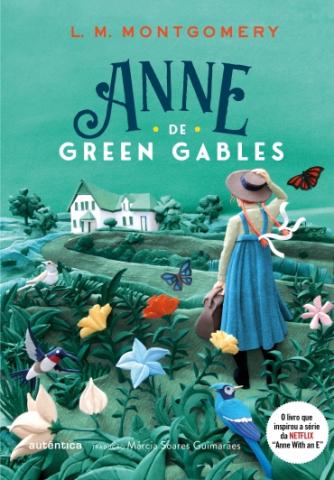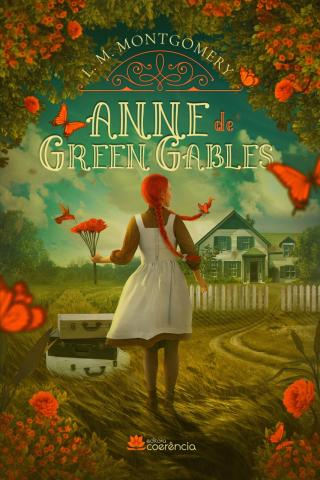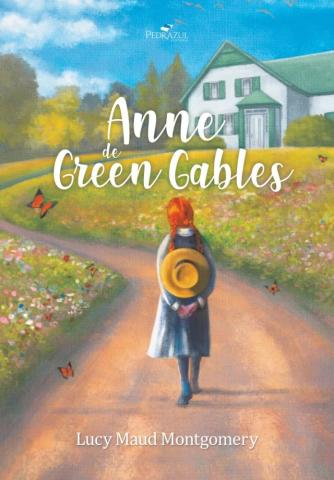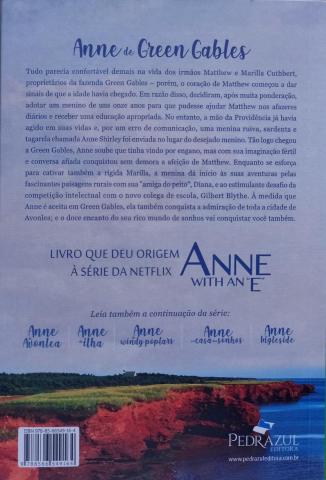Applying the theoretical contributions of the reception theories of Hans Robert Jauss, this short essay discusses the reception of L.M. Montgomery’s Anne of Green Gables in the Brazilian context, reflecting on the reasons that this novel became popular and flourished in several translations and adaptations only recently; more specifically, the essay relates this to the growth of reading levels, a government initiative for public school libraries, and the television series adaptation Anne with an “E.”
L.M. Montgomery’s Anne of Green Gables achieved early worldwide success and, since its availability in the public domain, it has motivated new waves of translations and adaptations in several countries. The novel became popular in many countries immediately after its publication in 1908 by L.C. Page and Company. According to Mary Rubio, by 1930 the book had already been translated into French, Dutch, Swedish, and Finnish and had sold over a million copies, putting Prince Edward Island on the North American literary map.1 Poushali Bhadury adds that, although Anne Shirley within the narrative of the first book in the series does not venture beyond Prince Edward Island, the same cannot be said of the many manifestations of Anne that have spread worldwide since the work was published.2 Despite this spread, the novel gained prominence in Brazil only recently. To reflect on the reasons that Anne of Green Gables became popular in Brazil after 2017, we will apply the reception theories of Hans Robert Jauss, analyzing the reception of this novel in the Brazilian context.
Portuguese Translations of Anne of Green Gables Published in Brazil: A Short History
Anne of Green Gables was first published in Brazil in Portuguese by Companhia Editora Nacional in 1939, with the title Anne Shirley. It was the sixty-fifth novel of a collection called “Biblioteca das moças” (“Ladies’ Library”), translated from English into Portuguese by Yolanda Vieira Martins. In 1956, Editora Nacional relaunched the novel in two parts, keeping the same title and translator. However, the remaining volumes of the Anne series were not published, probably due to low sales of the first novel. Then, in 2009, Martins Fontes published a new edition, translated by Maria do Carmo Zanini and Renée Eve Levié and titled Anne de Green Gables, to celebrate one century of the novel. In 2013, this edition of Anne of Green Gables was selected for inclusion in the collections of the Programa Nacional Biblioteca da Escola (PNBE), a government initiative that provides books for public-school libraries. That said, the Martins Fontes’s edition obtained high sales within the school-library collection. This initiative has contributed to the democratization and recognition of Montgomery’s work among students, which has increased the number of readers in Brazil; however, it has not prompted sales outside of school libraries. Nevertheless, the other volumes of the Anne series were not published by Martins Fontes. Only in 2015, the publisher Pedrazul announced a new edition of Anne of Green Gables. Between 2015 and 2019, this publisher pioneered the publishing of the entire collection about Anne Shirley, as translated by Tully Ehlers. Yet, Montgomery’s novel still did not captivate Brazilian readers. There were no reviews of this book, and it was not found on Brazilian bestseller lists.
As the appendices below indicate, this scenario changed significantly with the release of the adaptation of Montgomery’s novel as the television series Anne with an “E” (2017–2019) by CBC/Netflix. In Brazil, the television series was both dubbed and released with captions in Portuguese. Its success with the Brazilian audience prompted Brazilian publishers to bring out new translations and editions of Montgomery’s works. They have created varied paratexts to capture the imagination of twenty-first-century youth, especially those who had watched the series. An example is the 2019 Brazilian edition of Anne de Green Gables by Editora Autêntica. It contains a stamp with the following information: “o livro que inspirou a série da Netflix Anne with an ‘E’” (“the book that inspired the Netflix series Anne with an ‘E’”).

Another example is the 2020 edition published by Coerência, which presents a cover inspired by Anne’s image in the television series: Anne is pictured on the cover with the same clothes and hairstyle as in some of the episodes of the series.

The fourth edition of Anne of Green Gables published by Pedrazul also contains the following information in its back cover: “o livro que deu origem à série da Netflix Anne with an ‘E’” (“the book that gave rise to the Netflix series Anne with an ‘E’”). This range of paratexts connects the novel to the adaptation.


While it is generally assumed that film adaptations are made of popular novels, the reverse occurred with Brazilian translations of the Anne books. The popularity of the television series preceded and was undoubtedly responsible for the popularity of the novels. The television adaptation helped reveal the vitality of Montgomery’s works since it fascinated Brazilian readers and helped put Montgomery’s novel on Brazilian bestseller lists for the first time since its original translation to Portuguese in 1939. This, in turn, generated academic discussions about the vitality and potential interpretations of Anne of Green Gables. Considering the Jaussian theories, we understand “vitality” as a vector that reveals the aesthetic value of a literary work, which comes from reception. The popularity of a novel in different time contexts reveals its permanence and how it can charm different readers than those for whom the book was first intended. Thus, a literary text is adapted only when it has vitality. The adapter is also a reader, capable of re-visioning a literary work, which is the reason that adaptation, another way of reading a novel, usually gives the original text an “updating existence.”3 Film and series adaptations must consider the new context of production/reception and the society’s current horizons of expectation to attract a new audience. Reception is, then, a parameter for defining the permanence of a literary work and its value. Adaptations to film and television series renew the literary text and reveal its “vitality” and its ability to delight new generations. In Brazil, after the “renewal” of Anne of Green Gables through its televised adaptation, readers found the novel captivating, and they began to appreciate Montgomery’s works more than one century after their original publication.
In a bibliographical survey, we found twenty-nine translated editions of Anne of Green Gables published or reissued in Brazil—twenty-four of them after the success of the series Anne with an “E.” (See Appendix A.) Most of these editions have ranked on the bestseller lists in the country: for instance, in the bestseller lists of the Brazilian magazine Veja, Amazon, and “Estante Virtual” (a famous bookseller in Brazil). Google Trends, a tool that allows for mapping the most-searched words on Google, also indicates that the search-term “Anne de Green Gables” was used especially in Brazil, notably after the launch of the television series Anne with an “E.”
Adaptations of Anne of Green Gables
The success of Anne with an “E” and the translations of Anne of Green Gables also led to adaptations of Montgomery’s novels being published in Brazil, mainly in comic-book and graphic-novel form. In 2020, Epifania Comics published a comic book called Anne de Green Gables with adapted text and illustrations by the Brazilian artist Marcio Zanini. The publisher Principis also released a comic book Anne de Green Gables with adapted text by Larissa Palmieri and illustrations by Brazilian artists Mario Cau and Fabi Marques. In 2022, Principis launched the American comic book Anne de Green Gables: uma Graphic novel, which contains an adapted text by Mariah Marsden and illustrations by Brenna Thummler.
Additionally, Montgomery’s novel was adapted for young children by the publishers Pé da Letra and Ciranda Cultural. These editions include verbal and imagery resources to attract younger readers. The edition published by Pé da Letra, Anne de Green Gables Infantil (Anne of Green Gables Infantile), contains an adapted text by Shirley Sodré and illustrations by André Carino. Ciranda Cultural’s edition has the title Anne de Green Gables and adapted text by Donaldo Buchweitz and illustrations by Júnior Caramez. This publisher also released two books of a longer anticipated series of illustrated books translated from English, written by Kallie George and illustrated by Abigail Halpin, that adapt the central chapters of Anne of Green Gables for a younger audience: A chegada de Anne (Anne Arrives) and A melhor amiga de Anne (Anne’s Kindred Spirits). In summary, then, in the Brazilian context, Montgomery’s Anne of Green Gables was adapted into a comic book or graphic novel three times, motivated four compilations, and was adapted to young children four times. (See Appendix B.)
Retellings, Spinoffs, and Other Books Inspired by Anne of Green Gables
Anne of Green Gables has also inspired four retellings published in Brazil. One of them, Karol com “K” (Karol with an “K”) by Edelweis Ritt, places Green Gables in a small city in São Paulo state, presenting a Black protagonist inspired by Anne but called Karol, not with an “E” but with a “K.” In addition, Ciranda Cultural published a colouring book Livro de colorir Anne de Green Gables (Anne of Green Gables Colouring Book), which contains illustrations by Vicente Mendonça. Mendonça also illustrated a compilation of popular quotations from Montgomery’s works called Bordando com as Estrelas (Embroidering with Stars) published by Ciranda Cultural.
Instituto Mojo de Comunicação, a non-profit association that seeks to bring different cultures together through new digital tools and methodologies, mainly through the publication of classical and contemporary books, published a compilation of poems and phrases mentioned in Anne of Green Gables, entitled Récita de Natal em Avonlea (Avonlea Christmas Recital), translated and edited by Ricardo Giassetti and Gabriel Naldi. The publisher Belas-Letras also published Anne de Green Gables–O Livro Oficial de receitas: pratos encantadores de Anne e seus amigos de Avonlea, a translation of Kate Macdonald Butler’s cookbook presenting dishes mentioned in Montgomery’s work. (For these and other retellings, spinoffs, and books inspired by Anne of Green Gables, see Appendix C.)
Conclusion
The continuous warm reception by new audiences across time, places, genres, and languages, of Anne of Green Gables and the other Anne books is remarkable. Irene Gammel believes that the theories of Jauss, especially his concept of horizons of expectation, contribute to our understanding of why Montgomery’s work has generated favourable responses in diverse cultural contexts: “[W]e also have to consider the contexts of the reading publics, including the diverse cultural contexts, as well as the layered responses to the novel over time—in the case of Anne, more than a century.”4 Because horizons of expectation are not static, because they change as society does, updating and constantly renewing themselves, it is natural that the literary text continues to generate new readings and new interpretations. In Brazil, the change of horizons of expectation caused by the growth of readers, a government reading initiative for public-school libraries, and especially the success of the television series all prompted new readings and interpretations of the narrative. Thus, new reading conditions provided a new reception and therefore a new effect on Montgomery’s works. This, in turn, highlights the vitality of Anne of Green Gables.
Therefore, the contemporary reception of Anne of Green Gables in a multitude of translations has been a phenomenon in Brazil. These translations have motivated other editions with paratextual value, adaptations to comic books and graphic novels, spinoffs and retellings, and various kinds of compilations, many of them Brazilian. Due to the brief scope of this essay, we cannot analyze all the editions mentioned above and included in the appendices, but we conclude that the literary work and its adaptations contribute significantly to the formation of critical young readers. We encourage teachers to work with Montgomery’s texts in school environments, especially in Brazil, where the book is part of public schools’ libraries. The novel has enthralled young Brazilian readers of today and has expanded their horizons of expectation, prompting discussions inside and outside academic spaces about Montgomery’s legacy, and the vitality and potential interpretations of Anne of Green Gables beyond North America.
Appendix A
(Portuguese translations of Anne of Green Gables published in Brazil, listed chronologically)
Anne Shirley. Translated by Yolanda Vieira Martins, Companhia Editora Nacional, 1939. Reissued in two parts in 1956.
Anne de Green Gables. Translated by Maria do Carmo Zanini and Renée Eve Levié, Martins Fontes, 2009.
Anne de Green Gables. Translated by Tully Ehlers, Pedrazul, 2015. 2nd ed., 2017; 3rd ed., 2018; 4th ed., 2019.
Anne de Green Gables. Translated by Márcia Soares Guimarães, Editora Autêntica, 2019.
Anne de Green Gables. Translated by Alexandre Barbosa de Souza, Nova Fronteira, 2019.
Anne de Green Gables. Translated by Anna Maria Dalle Luche, Martin Claret, 2019.
Anne de cabelos ruivos [Anne’s Red Hair]. Translated by João Sette Camara, Ciranda Cultural, 2019.
Anne de Green Gables. Translated by João Sette Camara, Principis/Ciranda Cultural, 2020. Reissued twice in 2021.
Anne de Green Gables. Translated by Karina Regina dos Santos Pereira, Pé da Letra, 2020. 2nd ed., 2021.
Anne de Green Gables. Translated by Adriana Zoudine, Instituto Mojo, 2020.
Anne de Green Gables. Translated by Barbara Menezes, Prime, 2020.
Anne de Green Gables. Translated by Fernanda Castro, Excelsior, 2020.
Anne de Green Gables. Translated by Barbara Menezes, Novo Século, 2020.
Anne de Green Gables. Translated by Giovanna Vaccaro and Lucas Fernandes, Coerência, 2020.
Anne de Green Gables (e-book). Translated by Sheila Koerich, Coleção Duetos, 2020.
Anne de Green Gables. Translated by Luciana Gomide, Lafonte, 2020.
Anne de Green Gables. Translated by Camila Peixoto, Bezz, 2020.
Anne de Green Gables. Translated by Júlia Rajão, Garnier, 2020.
Anne de Green Gables. Translated by Débora Isidoro, Temporalis, 2021.
Anne de Green Gables. Translated by Souza e Cruz, Penkal, 2021.
Anne de Green Gables. Translated by Barbara Menezes, Amoler Ltda., 2022.
Appendix B
(Adaptations of Anne of Green Gables, listed chronologically)
Anne de Green Gables infantil [Anne of Green Gables Infantile]. Adapted by Shirley Sodré and illustrated by André Carino, Pé da Letra, 2021.
Anne de Green Gables. Adapted by Donaldo Buchweitz and illustrated by Júnior Caramez, Ciranda Cultural, 2021.
A chegada de Anne [Anne Arrives]. Adapted by Kallie George and illustrated by Abigail Halpin, translated by Patricia Chaves, Ciranda Cultural, 2021.
A melhor amiga de Anne [Anne’s Kindred Spirits]. Adapted by Kallie George and illustrated by Abigail Halpin, translated by Patricia Chaves, Ciranda Cultural, 2021.
Anne de Green Gables. Adapted and illustrated by Marcio Zaninin, Epifania Comics, 2020.
Anne de Green Gables em quadrinhos [Comic Book Anne of Green Gables]. Adapted by Larissa Palmieri and illustrated by Mario Cau and Fabi Marques, Principis, 2021.
Anne de Green Gables: uma Graphic novel [Anne of Green Gables: A Graphic Novel]. Adapted by Mariah Marsden and illustrated by Brenna Thummler, Principis, 2022.
Appendix C
(Retellings, spinoffs, and other books inspired by Anne of Green Gables, listed chronologically)
Livro de colorir Anne de Green Gables [Anne of Green Gables Colouring Book]. Illustrated by Vincent Mendonça, Ciranda Cultural, 2021.
Anne de Green Gables–O Livro Oficial de receitas: pratos encantadores de Anne e seus amigos de Avonlea [The Anne of Green Gables Cookbook: Charming Recipes from Anne and Her Friends in Avonlea]. By Kate Macdonald Butler, translated by Carolina Caires Coelho, Belas-Letras, 2021.
Récita de Natal em Avonlea [Avonlea Christmas Recital]. Edited and translated by Ricardo Giassetti and Gabriel Naldi, Instituto Mojo, 2021.
Bordando com as estrelas: as melhores frases de Anne de Green Gables e Lucy Maud Montgomery [Embroidering with Stars: The Best Phrases from Anne of Green Gables by Lucy Maud Montgomery]. Illustrated by Vicente Mendonça, Ciranda Cultural, 2021.
Karol com “K” [Karol with a “K”]. By Edelweis Ritt, Coerência, 2021.
About the authors: Tatiane Rodrigues Lopes dos Santos is a Ph.D. candidate in literature at the Assis campus of São Paulo State University (UNESP), one of Brazil’s leading research universities. She is a master of literature and has a teacher’s degree in languages (Portuguese and English) from UNESP, where she was an undergraduate researcher. Her ongoing research (2021–2023) on L.M. Montgomery’s Anne of Green Gables reflects on the importance of this novel on the formation of critical young readers in the Brazilian school system. She is one of the first scholars to research and publish on Montgomery’s novels in the context of literary works for Brazilian youth. Email address: tatiane.lopes@unesp.br
Eliane Aparecida Galvão Ribeiro Ferreira holds a Ph.D. in literature from the Assis campus of São Paulo State University (UNESP). Her research focuses on literature, reading, and teaching, especially on the formation of critical young readers. She is a professor at UNESP and the coordinator of the master’s degree and Ph.D. program in literature of UNESP – Assis campus. She is a member of the following Research Groups: “Leitura e Literatura na Escola” (UNESP-Assis/SP), “Literatura Infantil e Juvenil: análise literária e formação do leitor” (UTFPR-Curitiba/PR), and “RELER–Grupo Interinstitucional de Pesquisa em Leitura” (PUC-Rio/RJ). She is also member of the ANPOLL group “Leitura e Literatura Infantil e Juvenil.” Email address: eliane.galvao@unesp.br
Acknowledgement: This work was supported by Pró-reitoria de Pós-graduação (PROPG) and Pró-reitoria de Graduação (PROGRAD) of UNESP.
Banner Image: Book cover of Anne of Green Gables, 2004. kindredspaces.ca, 828 AGG-FOLIO.
Works Cited
Bhadury, Poushali. “Fictional Spaces, Contested Images: Anne’s ‘Authentic’ Afterlife.” Children’s Literature Association Quarterly, vol. 36, no. 2, 2011, pp. 214–37.
Gammel, Irene. “Introduction: Reconsidering Anne’s World.” Anne’s World: A New Century of Anne of Green Gables, edited by Irene Gammel and Benjamin Lefebvre, U of Toronto P, 2010, pp. 3–16.
Jauss, Hans Robert. A história da literatura como provocação à teoria literária [Literary History as a Challenge to Literary Theory]. Translated by Sérgio Tellaroli, Editora Ática, 1994.
Rubio, Mary. “Satire, Realism, and Imagination in Anne of Green Gables.” Canadian Children’s Literature, vol. 1, no. 3, 1975, pp. 27–36.
